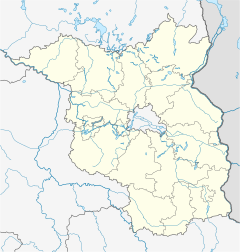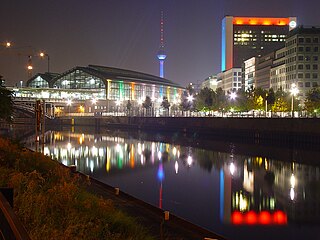
The Berlin S-Bahn is a rapid transit railway system in and around Berlin, the capital city of Germany. It has been in operation under this name since December 1930, having been previously called the special tariff area Berliner Stadt-, Ring- und Vorortbahnen. It complements the Berlin U-Bahn and is the link to many outer-Berlin areas, such as Berlin Brandenburg Airport. As such, the Berlin S-Bahn blends elements of a commuter rail service and a rapid transit system.

Märkisches Viertel is a German locality (Ortsteil) in the borough (Bezirk) of Reinickendorf in Berlin. Its name refers to the March of Brandenburg.
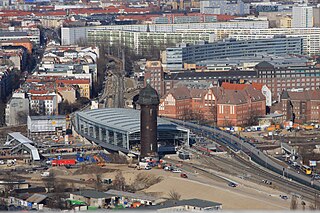
Berlin Ostkreuz station is a station on the Berlin S-Bahn suburban railway and the busiest interchange station in Berlin. It is in the former East Berlin district of Friedrichshain, now part of the borough of Friedrichshain-Kreuzberg. A smaller part of the station is in Rummelsburg, part of the borough of Lichtenberg. The station is a Turmbahnhof with the Berlin–Frankfurt (Oder) railway and the Prussian Eastern Railway on the lower level and the Berlin Ringbahn on the upper level. It is used by a total of around 235,000 passengers every day on eight lines, entering or leaving.

Karlsruhe Hauptbahnhof is a railway station in the German city of Karlsruhe. The station is classified as a Category 1 station, as it is a major hub where several railways connect.

Lehnitz is a railway station in the district of Lehnitz, Oranienburg, Germany. It is served by route S1 of the Berlin S-Bahn, with trains in both directions stopping every 20 min during the hours of operation.
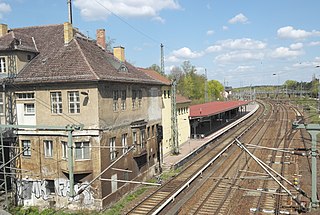
Birkenwerder is a railway station in the town of Birkenwerder, Brandenburg, Germany. The station lies of the Berlin Northern Railway and the train services are operated by Deutsche Bahn including Berlin S-Bahn services.

Berlin Westkreuz is a station in the Charlottenburg district of Berlin. It is served by the S-Bahn lines S3, S41, S42, S46, S5, S7 and S9 and so represents a major interchange point on the Berlin S-Bahn network. It lies at the opposite end of the Stadtbahn to Ostkreuz and is one of the four main stations on the Ringbahn.

Berlin-Lichtenrade station is a station on the Berlin–Dresden railway in the locality of Lichtenrade in the Berlin borough of Tempelhof-Schöneberg. It is served by Berlin S-Bahn line S2.
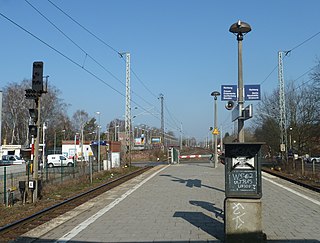
Blankenfelde station is on the Berlin–Dresden railway in the locality of Blankenfelde in the municipality of Blankenfelde-Mahlow in the district of Teltow-Fläming in the German state of Brandenburg. The station consists of two sections that are structurally separate from each other. One section is located just south of the Karl-Marx-Straße level crossing and consists of an island platform for regional and long-distance services. The other section lies north of Karl-Marx-Straße and is the southern terminus of Berlin S-Bahn line S2. On the official S-Bahn maps its name is styled Blankenfelde to avoid possible confusion with Blankenfelde locality in the Pankow district in northern Berlin.

Adlershof is a railway station in the district of Adlershof in Berlin. It is located on the Berlin–Görlitz railway and is served by lines S45, S46, S8, S85, and S9 of the Berlin S-Bahn.

Oberspree is a railway station in the Treptow-Köpenick district of Berlin on the Schöneweide–Spindlersfeld branch line. It is served by the S-Bahn line S47.

Berlin-Hohenschönhausen is a railway station in the Lichtenberg district of Berlin. The station is located on the Berlin outer ring railway.

Ahrensfelde station is a station serving regional and S-Bahn services in the Berlin borough of Marzahn-Hellersdorf. It is located on the border of Berlin just outside the municipality of Ahrensfelde, which is in the state of Brandenburg. The station has three platform edges, one side platform for the S-Bahn, and an island platform for Regionalbahn and S-Bahn services.

The Berlin–Görlitz railway is a main line railway in the German states of Berlin, Brandenburg and Saxony, which was originally built and operated by the Berlin-Görlitz Railway Company. The line runs through Lusatia from Berlin via Cottbus to Görlitz. It is one of the oldest lines in Germany, opened in 1866 and 1867.

Wustermark station is a railway station in the town of Wustermark in the Havelland region of the German state of Brandenburg, to the west of Berlin. The station is located on the Berlin–Lehrte railway and is connected with the Jüterbog–Nauen railway, part of which became part of the Berlin outer ring in the 1950s. It is classified by Deutsche Bahn as a category 5 station.
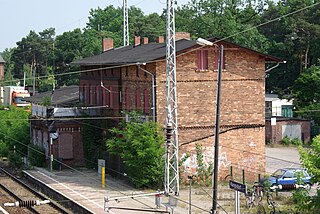
Rangsdorf station is a station in the locality of Rangsdorf in the district of Teltow-Fläming in the German state of Brandenburg. It is located at kilometre 24.3 of Berlin–Dresden railway. Until 1919, the western part of the station was served by the Royal Prussian Military Railway.

S-Bahn Mitteldeutschland represents an enlargement of the previous Leipzig-Halle S-Bahn. It is an electric rail public transit system operating in the metropolitan area of Leipzig-Halle, Germany. This S-Bahn network developed from two separate S-Bahn networks of Halle (Saale) and Leipzig, which were established separately in 1969 and then linked in 2004. With the opening of the Leipzig City Tunnel on 15 December 2013 as a new artery, the network was extended for the first time to the federal states of Thuringia and Brandenburg. With a system length of 802 km (498 mi), it is the largest S-Bahn network in Germany, displacing the long-time title holder Rhine-Ruhr S-Bahn from that position. The locomotive-hauled double-decker trains partly dating back to the DDR-era have been largely replaced by electric multiple unit Bombardier Talent 2 trains, but some older trains are still used during rush hour.

The Waßmannsdorf station is a stop of the Berlin S-Bahn in Waßmannsdorf in the municipality of Schönefeld on the Grünau Cross–Berlin Brandenburg Airport railway. It was completed in October 2011 and opened on 26 October 2020, five days before Berlin Brandenburg Airport (BER) opened on 31 October 2020. A railway station already existed in the village from 1951 to 1982. It was not located at the same place and was exclusively a depot (Betriebsbahnhof) on the Berlin outer ring.

Fürstenwalde (Spree) station is the station of the city of Fürstenwalde/Spree in the German state of Brandenburg. It was opened on 23 October 1842 on the Berlin-Frankfurt railway. The station was then about one kilometre north of the town on Müncheberger Chaussee. The station building still exists and is one of the oldest in Germany.

The Grünau Cross–Berlin Brandenburg Airport railway is a railway line in the south of Berlin, the capital of Germany, and in the adjacent areas of Brandenburg. It is used by the Berlin S-Bahn. The first, 5.9-kilometre-long (3.7 mi) section was opened in 1962 and served mainly as a connection to Berlin Schönefeld Airport and the associated long-distance station. In 2011, a 7.7-kilometre-long (4.8 mi) extension went into operation to connect with Berlin Brandenburg Airport (BER). Due to delays in the commissioning of BER Airport, this section has only been used for public transport since October 2020.

